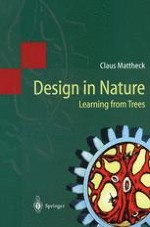1998 | OriginalPaper | Chapter
Claws and Thorns: Shape-Optimized by Success in the Lottery of Heredity
Author : Prof. Dr. Claus Mattheck
Published in: Design in Nature
Publisher: Springer Berlin Heidelberg
Included in: Professional Book Archive
Activate our intelligent search to find suitable subject content or patents.
Select sections of text to find matching patents with Artificial Intelligence. powered by
Select sections of text to find additional relevant content using AI-assisted search. powered by
The experienced finger-wrestler in the pub might think he had a feel for the loads that a good rip-hook has to withstand. Quite wrong! The load in finger-wrestling is a slow quasi-static pull. It is more accurate to imagine jumping up beneath a high washing-line and hooking on to it while swinging freely: a dynamic process which would arouse some self-doubt in even the fittest finger-wrestler. And yet this kind of load is what happens when a tiger lands on the back of a bullock, buffalo etc., claws itself on firmly, is shaken about and finally conquers or is hurled down. A tiger weighs about 200 kp, so just imagine having to hold some swinging sacks full of potatoes with one’s finger nails. As the tiger does not hurt itself in doing this, its claws must be especially well shape-optimized, and the horn material must also exhibit a high tensile strength. The striped predator cannot allow the slightest local excess stress which would mean a design weak point and could have painful consequences for it during the tussle. These few preliminary observations make the tiger’s claw — or the claws of predators in general — an attractive object for study. The FEM and the CAO methods were used in the mechanical analysis [25]. Figure 139 gives an overview of the results of the calculations. The initial design was a hook of `engineered’ shape, consisting of two arcs of a circle. As in all the cases considered previously, here again the circular contour is a design catastrophe with a dangerous stress maximum in the last third of the claw (Fig. 139B), as also emerges from the stress distribution for the non-optimized circular contour. These stresses are reduced and homogenized after using the CAO method. A claw formed as a logarithmic spiral is produced, and this must therefore be the optimum form.
